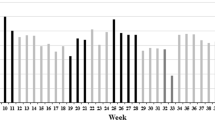Summary
Athletes who need high endurance capacity often use training at moderately high altitude (1500–3000 m) to improve oxygen delivery and utilization because of a hypoxia-induced increase of the red blood cell volume and adaptations at the muscular level. As maximal heart rates decrease at high altitude and plasma lactate levels for a given workload change during prolonged exposure to high altitude, it can be difficult to control and adapt the intensity and duration of the work-outs. Furthermore, maximal performance capacity decreases and therefore training intensity at high altitude is usually reduced compared to training at sea level. To avoid these disadvantages at high altitude a concept of living at moderately high altitude and training at lower elevations, termed ”live high – train low” evolved, opposing the conventional concept of ”live high – train high”. A third option using a hypobaric chamber (”live low – train low”) is hardly used anymore for training athletes. Studies on the effects of conventional high-altitude training for the improvement of athletic performance often lack a rigorous controlled design and yield controversial results. Regarding the new concept of ”live high – train low” there is only one controlled study on college athletes and it shows a minor advantage of this new approach compared to conventional high-altitude training. However, training concepts are especially important for elite competitive athletes, and controlled studies with such individuals are very difficult to perform. Therefore, it appears that today we cannot answer the question of whether altitude-specific physiologic factors or non-altitude-related benefits of training camps account for the success of individual athletes.
Zusammenfassung
Zahlreiche Athleten aus Sportarten, in denen die Ausdauerleistungsfähigkeit eine bedeutende Rolle spielt, führen ein Training in mittlerer Höhe (1500–3000 m) durch mit dem Ziel, unter den Hypoxiebedingungen der Höhe zum einen die Sauerstofftransportkapazität durch Vergrößerung des Blutvolumens und zum anderen die Sauerstoffausschöpfung in der Peripherie durch Anpassungsreaktionen in der Skelettmuskulatur zu verbessern. Änderungen in der Herzfrequenzregulation und dem Laktatstoffwechsel erschweren eine Trainingssteuerung in der Höhe, wo zudem die Trainingsintensität aufgrund einer verminderten maximalen Leistungsfähigkeit niedriger liegt als im Flachland. Um diese Nachteile zu vermeiden, wurde in neueren Untersuchungen die Hypoxie für die Erholungsphase genutzt, das Training aber in niedrigerer Höhe durchgeführt gemäß dem Motto „oben wohnen, unten trainieren“ gegenüber „oben wohnen, oben trainieren“. Bei einer weiteren, in der Praxis heute nur noch selten angewandten Form des Höhentrainings wird in einer Unterdruckkammer trainiert („unten wohnen, oben trainieren“). In den verfügbaren Studien wurden widersprüchliche Ergebnisse hinsichtlich der Frage erzielt, ob durch ein Höhentraining die Leistungsfähigkeit im Flachland gesteigert werden kann. Zum Konzept „oben wohnen, unten trainieren“ gibt es bisher nur eine vollständig veröffentlichte, kontrollierte Studie, die auch nur einen kleinen Vorteil gegenüber den anderen Formen des Höhentrainings zeigt. Das Höhentraining spielt vor allem im Hochleistungssport eine bedeutende Rolle, doch ist es schwierig, gerade mit Hochleistungssportlern kontrollierte Studien durchzuführen, so daß es sicher noch einige Zeit dauern wird zu klären, ob hinter den großen Erfolgen einzelner Athleten nach Höhentraining eher Mythos oder doch leistungsphysiologisch belegbare Wirklichkeit steckt.
Similar content being viewed by others
Author information
Authors and Affiliations
Rights and permissions
About this article
Cite this article
Friedmann, B., Bärtsch, P. High altitude training: benefits, problems, trends. Orthopäde 26, 987–992 (1997). https://doi.org/10.1007/PL00003353
Published:
Issue Date:
DOI: https://doi.org/10.1007/PL00003353




